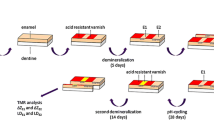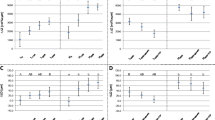Abstract
The aim of the present study was to evaluate the remineralization potential of five dentifrices with different fluoride concentrations. Initial caries lesions were created in 72 cylindrical enamel blocks from deciduous teeth. The specimens were randomly distributed among six experimental groups corresponding to six experimental periods. Each of the six volunteers carried two deciduous enamel specimens fixed in an intraoral appliance for a period of 4 weeks. They brushed their teeth and the enamel blocks at least two times a day with dentifrices containing 0 ppm (period 1), 250 ppm (period 2), and 500 ppm fluoride (period 3), respectively. A second group of volunteers (n = 6) used dentifrices with a fluoride content of 0 ppm (period 4), 1,000 ppm (period 5), or 1,500 ppm (period 6). At the end of the respective period, the mineral content was determined by transversal microradiography (TMR). The use of dentifrices containing 500 ppm fluoride (38% MR), 1,000 ppm fluoride (42% MR), and 1,500 ppm fluoride (42% MR) resulted in a statistically significant higher mineral recovery compared to the control group (0 ppm fluoride). Mineral recovery was similar after use of dentifrices containing 0 and 250 ppm fluoride (24%; 25%). It is concluded that it is possible to remineralize initial carious lesions in deciduous enamel in a similar way as it has been described for enamel of permanent teeth.


Similar content being viewed by others
References
Ammari AB, Bloch-Zupan A, Ashley PF (2003) Systematic review of studies comparing the anti-caries efficacy of children’s toothpaste containing 600 ppm of fluoride or less with high fluoride toothpastes of 1, 000 ppm or above. Caries Res 37:85–92
Biesbrock AR, Bartizek RD, Gerlach RW, Jacobs SA, Archila L (2003) Effect of three concentrations of sodium fluoride dentifrices on clinical caries. Am J Dent 16:99–104
Bjarnason S, Finnbogason SY (1991) Effect of different fluoride levels in dentifrice on the development of approximal caries. Caries Res 25:207–212
Buchalla W, Attin T, Schulte-Mönting J, Hellwig E (2002) Fluoride uptake, retention, and remineralization efficacy of a highly concentrated fluoride solution on enamel lesions in situ. J Dent Res 81:329–333
Buskes JA, Christoffersen J, Arends J (1985) Lesion formation and lesion remineralization in enamel under constant composition conditions. A new technique with applications. Caries Res 19:490–496
De Almeida BS, Da Silva Cardoso VE, Buzalaf MA (2007) Fluoride ingestion from toothpaste and diet in 1- to 3-year-old Brazilian children. Community Dent Oral Epidemiol 35:53–63
Dunipace AJ, Hall AF, Kelly SA et al (1997) An in situ interproximal model for studying the effect of fluoride on enamel. Caries Res 31:60–70
Holt RD, Nunn JH, Rock WP, Page J (1996) Fluoride dietary supplements and fluoride toothpastes for children. Int J Paediatr Dent 6:139–142
Marinho VC, Higgins JP, Sheiham A, Logan S (2003) Fluoride toothpastes for preventing dental caries in children and adolescents. In: The Cochrane Library, Issue 2, Oxford: Update Software
Petersson LG, Edwardsson S, Koch G, Kurol J, Lodding A (1995) The effect of a low fluoride containing toothpaste on the development of dental caries and microbial composition using a caries generating model device in vivo. Swed Dent J 19:83–94
Sønju Clasen AB, Øgaard B, Duschner H, Ruben J, Arends J, Sönju T (1997) Caries development in fluoridated and non-fluoridated deciduous and permanent enamel in situ examined by microradiography and confocal laser scanning microscopy. Adv Dent Res 11:442–447
Stookey GK, Mau MS, Isaacs RL, Gonzalez-Gierbolini C, Bartizek RD, Biesbrock AR (2004) The relative anticaries effectiveness of three fluoride-containing dentifrices in Puerto-Rico. Caries Res 38:542–550
Ten Cate JM, Exterkate RA, Buijs MJ (2006) The relative efficacy of fluoride toothpastes assessed with pH cycling. Caries Res 40:136–141
Thaveesangpanich P, Itthagarun A, King NM, Wefel JS (2005) The effects of child formula toothpastes on enamel caries using two in vitro pH-cycling models. Int Dent J 55:217–223
Twetman S, Axelsson S, Dahlgren H et al (2003) Caries-preventive effect of fluoride toothpaste: a systematic review. Acta Odontol Scand 61:347–355
Wefel JS, Jensen ME, Triolo PT, Faller RV, Hogan MM, Bowman WD (1995) De/remineralization from sodium fluoride dentifrices. Am J Dent 8:217–220
Acknowledgements
We gratefully acknowledge the support of GABA International AG, Bale/Switzerland.
The authors thank Ms. Petra Heß for her excellent assistance.
Conflict of interest
The authors declare that they have no conflict of interest.
Author information
Authors and Affiliations
Corresponding author
Rights and permissions
About this article
Cite this article
Hellwig, E., Altenburger, M., Attin, T. et al. Remineralization of initial carious lesions in deciduous enamel after application of dentifrices of different fluoride concentrations. Clin Oral Invest 14, 265–269 (2010). https://doi.org/10.1007/s00784-009-0290-4
Received:
Accepted:
Published:
Issue Date:
DOI: https://doi.org/10.1007/s00784-009-0290-4




